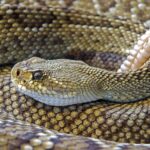The honey badger (Mellivora capensis) is one of nature’s most tenacious and fearless creatures, admired not only for its relentless determination but also for its resilience and adaptability in harsh environments. Found across Africa, the Middle East, and parts of Asia, this small yet formidable animal has earned a reputation for being virtually fearless, often taking on much larger opponents in the wild.
Appearance and Physical Characteristics
Despite its relatively small size—typically around 9-11 inches tall at the shoulder and 2-3 feet long—honey badgers are powerfully built. They have thick, tough skin that offers protection against bites and stings, which comes in handy given their dangerous diet and bold behavior. Their coat is black on the underside with a characteristic white or grayish stripe running from the top of the head to the tail. This distinct coloration acts as a warning to potential predators and competitors, signaling that the honey badger is not to be trifled with.
Their sharp claws, strong jaws, and muscular bodies allow them to dig burrows, break into beehives, and even fight off predators. Honey badgers have the ability to run quickly and swim with ease, adding to their adaptability in various environments.
Fearless and Ferocious Behavior
What truly sets the honey badger apart is its sheer fearlessness. Stories of honey badgers standing their ground against lions, hyenas, or even humans are not uncommon. Their confidence comes from a combination of their physical toughness and an aggressive nature. When threatened, a honey badger will make fierce growling sounds, puff itself up, and charge at attackers with little regard for their size.
This tenacity extends to hunting as well. Honey badgers are omnivores, meaning they eat both plants and animals. Their diet includes a wide range of food, from fruits and berries to small mammals, birds, and reptiles. But the honey badger is most famous for its love of honey, which it often seeks out by raiding the nests of bees—hence its name. They’ve developed immunity to bee stings and venom, allowing them to feast on honey and bee larvae without fear. In some cases, they’ve been observed eating venomous snakes like cobras, further adding to their legend.
Intelligence and Resourcefulness
Though known for their aggressive nature, honey badgers are also highly intelligent. Researchers have observed them using tools, such as sticks or stones, to access food. In captivity, honey badgers have been known to escape from enclosures by using clever techniques, including unlocking doors and stacking objects to climb out. This intelligence, combined with their adaptability, makes them remarkably successful survivors in the wild.
A Symbol of Resilience
The honey badger has become a symbol of toughness and determination. In many cultures, it is respected as a warrior of the animal kingdom, and the phrase “Honey Badger don’t care” has become a popular meme, highlighting its bold and fearless attitude.
Despite their fearsome reputation, honey badgers face threats from habitat loss and human activity. As humans encroach on their natural habitats and the availability of food diminishes, honey badgers are increasingly coming into contact with people, sometimes resulting in conflict. Conservation efforts are crucial to ensure that these remarkable creatures continue to thrive in the wild.
Conclusion
The honey badger is a remarkable example of nature’s extremes—a small animal that defies expectations with its toughness, intelligence, and sheer will to survive. Whether fending off lions or stealing honey from bees, it is a creature that captures the imagination and reminds us of the power of resilience in the natural world.
For those looking to embody a spirit of determination and fearlessness, look no further than the honey badger—a true warrior in the animal kingdom.



